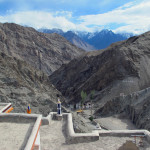
Ladakh, the eastern portion of Jammu and Kashmir state (J&K) – and its capital Leh – have long been at the crossroads of global trade. Or at least trade stretching from Persia to China.
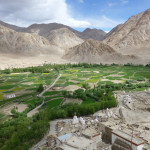
Here is where the caravan routes along the old Silk Road met, as traders on horseback and camel finished their journeys after negotiating the precipitous trails through the Himalayas. Leh had to be a place of some relief then as now, as it opens into broad valleys along the Indus River and relatively easy passage to points west and east, or southward over final passes to the plains. They called the rest areas along these routes “sarai,” a name that still appears in various places for modern traders like the goods truckers or the 12 kiloliter oil trucks that move endlessly from Manali to Leh.
Trade with China and Tibet and westward as well continued into the 20th century until political and border disputes halted things. To the east, Tibet was roped off. The partition into India and Pakistan and subsequent wars between them made the entire state of J & K, including the crossroads of Leh, militarily strategic for the defense of the nation. Closed to tourists and effectively to trade until about 20 years ago, the area is rapidly opening up once more – though permits and passport checkpoints remain a bureaucratic requirement usually handled by travel agencies.
The military is perhaps the most obvious community here, with its own compounds and shops, self-contained villages of barracks, warehouses and offices that look like any country’s military compounds. Nonetheless, the needs of the soldiers spill over into the town.
As befits a reviving crossroads, other distinct sub-communities now characterize Leh as well.
The most apparent to us are other foreigners. Westerners crowd around Changspa Lane, appropriately on the western side of town, with its agglomeration of grand hotels, inns and backpacker resting spots,. The long street, and now others like Fort Road, also offer restaurants with continental cuisines, coffee shops and tour/trekking agencies. Many come here for the mountain treks, or for the cool dry clean air of the mountains at a time when the rest of India is user-unfriendly due to heat or monsoons.
Apparently a movie partly filmed here called “Three Idiots” pushed tourism a bit further along, but we’ve yet to catch that one ourselves.
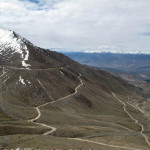
In any case, more westerners come to make photo pilgrimages to the monasteries, or for car-trekking through the astonishing landscape that welcomed traders of the past. The modern visitors spread along the valleys like the Indus channeled by steep scree covered mountainsides, motor through the grandeur and eagle’s eye delight of the high mountain passes to the north and south, or delight in neighboring valleys like the broad Nubra, hemmed in by red hills and craggy mountains whose appearance changes constantly in the shifting light and cloud.
Now middle class Indians flock to the area as well, often in large family groups. At our hotel, 18 Indians from three generations were touring the area; a few days later, a family of 26 took their place. At the Nubra Valley, we spent an engaging evening with a third Indian family completing two weeks touring Ladakh, a mix of part of the family now living in Dubai and their relatives from Madhya Pradesh.
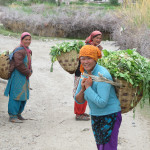
A second community evident here consists of Tibetan refugees, many of whom reside in camps at the outskirts of Leh. Two or three open-air markets purport to offer myriad handicrafts made by members of the community and sold for their livelihood to the visiting westerners. Most of the wares, however, look like souvenir objects or cheap adornments typical of tourist markets across Asia. The local language is predominantly Nepali, an old link among the Himalayan people of several countries and another sign of Ladakh’s role a a crossroads. You don’t say the Hindu greeting of “Namaste” up here, but “Jullay” with an especially bright lilt in your voice and the positioning of at least one hand before your face as if in prayer.
The younger, more educated from this community serve extensively in the hotels and in the tourist guide/driving trade, joined by numerous Nepalese for whom the borders are quite a bit more porous.
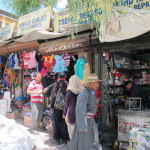
A third community, of course, are the native Ladakhians. They are most obvious in the neighboring villages, and look to us more Tibetan in features, but clearly are the mainstay of the core activity of the town, at the open air markets and the goods bazaars in the center. They deal in modern, practical goods as well as items reminiscent of ancient trading – woolens, silks, leathers and furs.
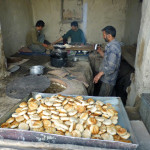
A fourth is the Muslim community, which was mostly visible before and after prayer times around the main mosque, the Jama Masjid. Just by the names over the shops, we could see that Muslims have remained active as shopowners and traders, a presence dating back to traders from the west as well as the ruling dynasties over northern India from the 12th century. J&K is at the Pakistan border, where millions shifted in both directions to join their religious brethren during the partition. Yet Leh’s Muslim population remains here,at peace with the largely Buddhist Ladakh, where Hinduism had little stronghold.
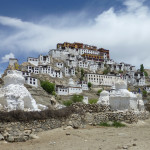
And then there are the monks and religious pilgrims. Tibetan Buddhism is the principal religion of Ladakh dating back before rigid borders, at least as far back as the 9th century. Still today locals and visitors head to the gonpas – or monasteries – in devotion. The monasteries themselves consist typically of a cluster of whitewashed stone buildings tumbling down a steep hillside above the valley floors.
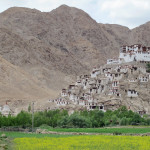
Anyone who has seen the hill towns in Italy, particularly the coast villages of Amalfi, knows what these look like. The big difference is that these are not secular, but spiritually centered villages of monks.
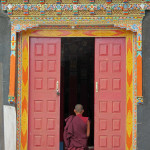
Except for prayer times, when the rhythmic chants fill the prayer halls and echo around the core buildings, these are quiet places. During festival times at the different monasteries, people travel from far afield to sit in the main open courts and watch the slowly unfolding ceremonies whose purpose is to ward off bad spirits of evil and temptation and welcome help on the way to forgiveness and enlightenment.
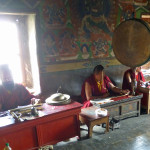
The gonpas still offer guesthouses for traveling monks or religious pilgrims, as they did in centuries past for those ancient traders. More modern guesthouses and hotels may have taken over in Leh, but all find rest here in one form or another as they gather in the geographic and spiritual crossroads of Ladakh.
(For more about the enchanting landscape and monasteries of the area, see the two posts, River Deep, Mountain High: Geographic Landscape of Ladakh and Spiritual Landscape of Ladakh.)
(Also, for more pictures from India, CLICK HERE to view the slideshow at the end of the India itinerary page.)


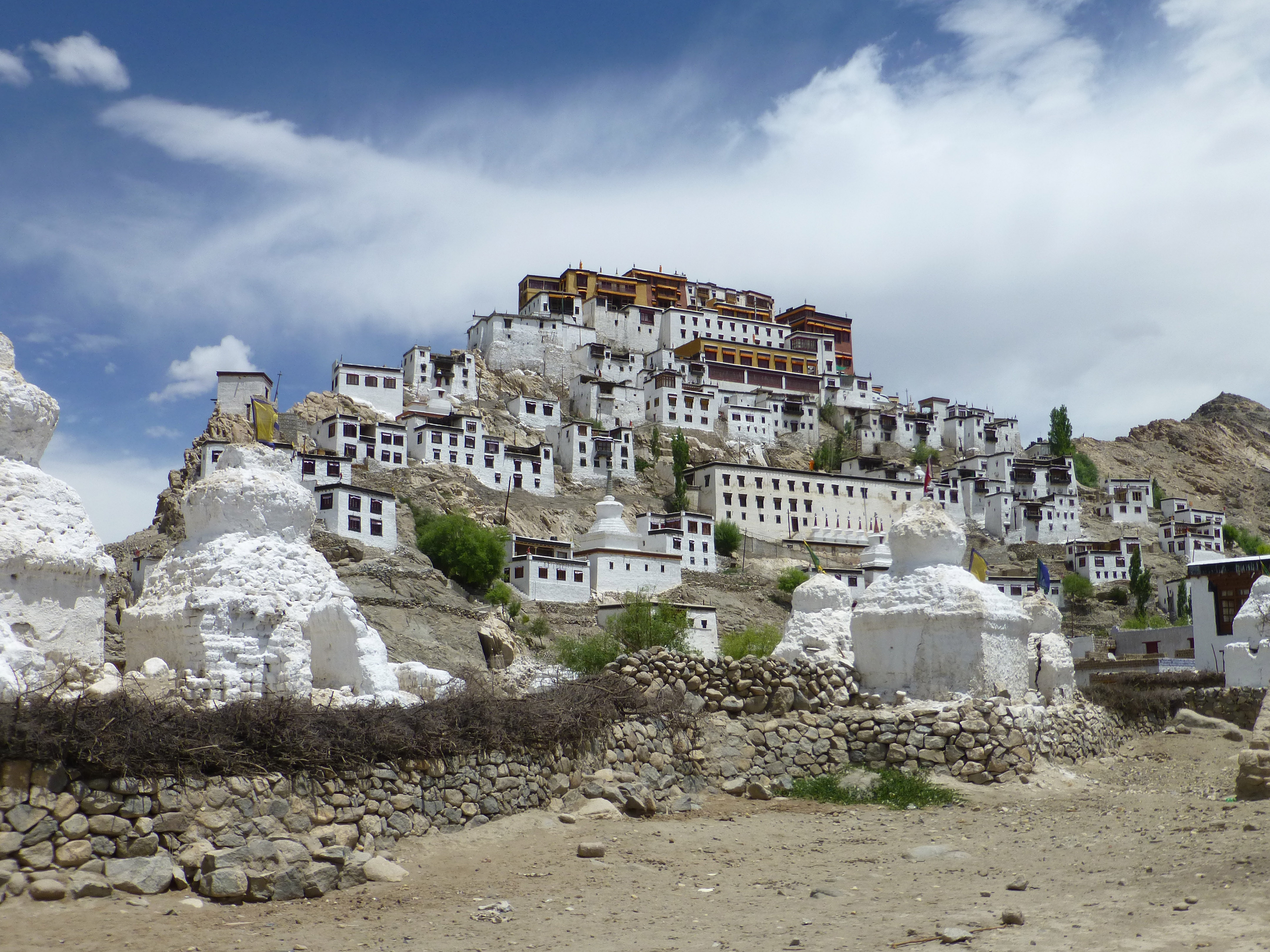
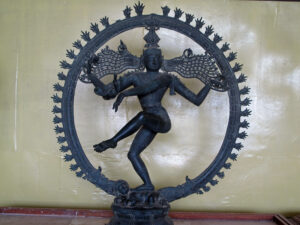
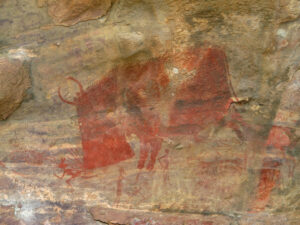
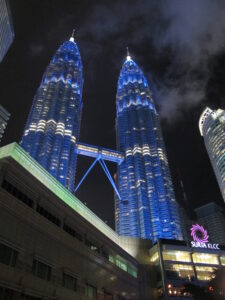
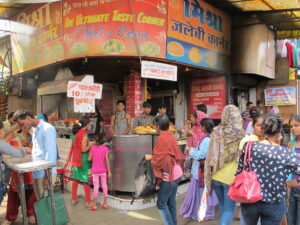
The monastery looks awesome….is this all above the tree-line?
The only trees in sight – and the only green – are those trees (generally poplars) and crops huddling around the villages as a result of their irrigation system tapping off the Indus and other rivers. The only other trees appeared at least 2000 to 3000 meters lower in altitude. The monasteries are awe-inspiring on the inside as well; we hope to publish a post about that shortly.